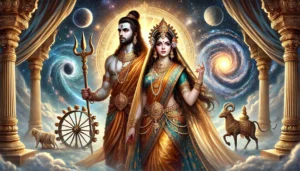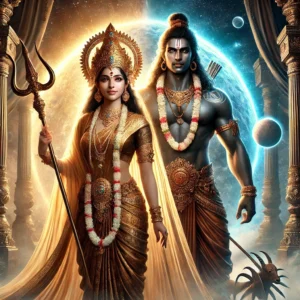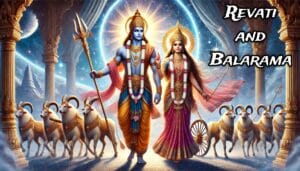
Revati and Balarama
Revati and Balarama: A Bride Lost in Time
The tale of Revati and Balarama is one of the most fascinating yet often overlooked stories in the vast mythology of Sanatan Dharma. It is a story that transcends time itself, blending science, spirituality, and destiny into a unique narrative. Revati, a princess from a different era, found herself displaced in time due to a cosmic miscalculation, yet her fate ultimately led her to the mighty Balarama, the elder brother of Lord Krishna.
This legend not only introduces us to concepts like time dilation but also teaches us valuable lessons about humility, acceptance, and divine will. Let’s explore this remarkable story in depth.
Revati – The Daughter of a Timeless King
Revati was the daughter of King Kakudmi, the powerful ruler of Kusasthali, a flourishing kingdom believed to be an earlier form of Dwaraka. She was no ordinary princess—her beauty, intelligence, and virtues were unparalleled, making her the most eligible bride of her time.
King Kakudmi was a loving father who wished to find the best possible husband for his daughter. However, being a wise and discerning ruler, he found no mortal prince worthy of Revati’s hand. Convinced that no one on Earth was good enough for her, he decided to seek divine guidance.
With this goal in mind, Kakudmi and Revati traveled to Brahmaloka, the celestial abode of Lord Brahma, to consult the Creator himself about an ideal groom for his daughter.
A Bride Lost in Time
Upon reaching Brahmaloka, King Kakudmi and Revati found Lord Brahma engrossed in divine music performed by the Gandharvas, celestial musicians of the gods. They patiently waited for their turn, believing that only a few moments had passed.
When they finally presented their list of suitors to Brahma, the divine creator laughed gently and revealed a shocking truth:
“O King, the men you seek for your daughter, their sons, and even their dynasties have long perished. While you spent mere moments in my world, thousands of years have passed on Earth. Your kingdom no longer exists, and the world has entered a new era—the Dwapara Yuga.”
Kakudmi was astounded. He had unknowingly fallen victim to the cosmic principle of time dilation—a concept that resonates even with modern physics. Time in the higher realms flowed differently than on Earth, and what seemed like minutes in Brahmaloka had translated to several Yugas (ages) in the mortal world.
The realization hit Kakudmi hard—his kingdom, his people, and everything he had once known were lost in the sands of time. He had entered a world that was completely unfamiliar to him.
Seeing his despair, Lord Brahma consoled him and revealed that a suitable match had already been arranged for Revati in this new age—Balarama, the mighty warrior and incarnation of Shesha Naga, the divine serpent who supports the universe.

Revati and Balarama
Table of Contents
The Return to Earth and a Changed World
With Brahma’s blessing, Kakudmi and Revati returned to Earth, only to find that everything had changed drastically. The grand civilization of Kusasthali had long disappeared, and the world had moved on into the Dwapara Yuga. The people, culture, and even physical stature of humans had evolved over time.
Undeterred, Kakudmi traveled to Dwaraka, the kingdom of Lord Krishna, where he met Balarama—the elder brother of Krishna and an embodiment of raw strength and righteousness. Balarama was known for his unwavering devotion to Dharma, his immense power, and his skill with the plow, which was both his weapon and his symbol of agricultural prosperity.
Recognizing him as the divine match ordained by Brahma, Kakudmi joyfully offered Revati’s hand in marriage.
The Challenge of Time: Revati’s Transformation
However, there was a unique challenge—Revati had been born in a much earlier Yuga, where humans were taller and physically larger than those of the present Dwapara Yuga. When she stood next to Balarama, she appeared to be a giantess, towering over everyone around her.
Understanding the situation, Balarama gently placed his divine weapon, the plow (Halayudha), on Revati’s head and pressed her down slightly, adjusting her stature to match the humans of the current era. This act not only reduced her size but also symbolized the transition from one Yuga to another, reinforcing the cosmic balance.
With this transformation complete, the wedding of Balarama and Revati was performed with great splendor, uniting two souls across time and space.
Revati’s Life as Balarama’s Consort
After their marriage, Revati adapted to the new world and became a devoted wife to Balarama. Unlike Krishna, who was deeply involved in political and philosophical matters, Balarama was more inclined toward agriculture, warfare, and the preservation of traditional values.
Revati and Balarama’s union was one of harmony, duty, and balance. She played a vital role in supporting her husband, standing by his side through the many wars and upheavals that occurred during the final years of the Dwapara Yuga.
As per some versions of the Mahabharata, Balarama was a neutral figure in the Kurukshetra war. While Krishna played a decisive role in shaping the fate of the Pandavas and Kauravas, Balarama chose a path of detachment, focusing on his personal dharma. Revati, too, remained away from the war, reflecting her deep-rooted wisdom and adherence to divine will.
Symbolism and Lessons from Revati and Balarama’s Story
The story of Revati and Balarama carries profound symbolism:
- The Concept of Time and Relativity
This tale illustrates the idea that time is not absolute but relative—an insight that aligns with modern scientific theories like Einstein’s Theory of Relativity. Time moves differently in different planes of existence, a concept that ancient Hindu scriptures had already grasped.
- Acceptance of Destiny and Change
Despite losing his world, Kakudmi did not dwell in sorrow. Instead, he accepted fate and found the best path for his daughter, symbolizing the need to embrace change rather than resist it.
- The Balance Between Strength and Grace
Revati’s marriage to Balarama symbolizes the union of strength (Balarama, the warrior) and grace (Revati, the refined princess). Their relationship highlights the balance needed in life—power must be guided by wisdom, and wisdom must be supported by strength.
- The Yuga Cycle and Human Evolution
Revati’s transformation to fit into the new age reflects the cyclical nature of time in Hindu cosmology, where each Yuga brings changes in human attributes, lifespan, and societal structure.

Revati and Balarama
Conclusion: A Love That Transcended Time
The tale of Revati and Balarama is a mesmerizing blend of myth, science, and philosophy. It reminds us that time waits for no one, yet destiny finds a way to bring together those who are meant to be. Revati, though lost in time, found her place in history as the beloved wife of Balarama, proving that divine will always prevails, no matter how uncertain the path.
Even today, this story remains a profound reflection on time, fate, and the eternal laws of Sanatan Dharma, teaching us that change is inevitable, but dharma remains the guiding force through all transitions.
FAQs on Revati and Balarama: The Bride Who Traveled Through Time:
- Who was Revati?
Revati was the daughter of King Kakudmi, the ruler of Kushasthali. She is known for traveling through time due to a visit to Brahmaloka, which led to her becoming the bride of Balarama, the elder brother of Lord Krishna.
- Why is Revati’s story considered a ‘time travel’ story?
King Kakudmi took Revati to Brahmaloka to find a suitable groom. However, time moves differently in higher realms. When they returned to Earth, thousands of years had passed, and all the men Kakudmi had considered for her marriage were long gone.
- How did Revati marry Balarama?
Upon their return, Lord Brahma advised Kakudmi that the only suitable match for Revati in the new era was Balarama, the powerful avatar of Vishnu. Balarama accepted Revati as his wife, adjusting her height and stature to fit the changed human form of Dwapara Yuga.
- What is the significance of Revati’s story in Sanatan Dharma?
Revati’s story highlights the concept of cosmic time, demonstrating how time flows differently in various realms. It also emphasizes divine destiny, as she was ultimately meant to marry Balarama, an avatar of Vishnu.
- Why did Balarama have to adjust Revati’s height?
Since Revati was from an earlier Yuga (Treta Yuga), humans were much taller and stronger. When she returned, she was significantly larger than people in Dwapara Yuga. Balarama gently pressed her shoulder with his plough weapon, adjusting her stature to fit the new age.
- What lessons can we learn from Revati and Balarama’s marriage?
- Time is relative—what seems short in one realm can be long in another.
- Destiny prevails—despite Kakudmi’s search for a groom, divine will led Revati to Balarama.
- Change is inevitable—Revati had to adapt to a new era, just as we must adapt to life’s changes.
7. What does Revati’s journey tell us about the concept of time in Hinduism?
In Hindu cosmology, time is not linear but cyclical, with different Yugas (ages) having distinct characteristics. Revati’s story demonstrates how time flows differently in different realms, similar to how time dilation is explained in modern physics.
- Why did King Kakudmi think no suitable groom was available for Revati?
Kakudmi had a list of eligible princes in mind, but when he returned from Brahmaloka, thousands of years had passed on Earth, and all those men were long dead. This left him with no options from his original list, forcing him to accept divine guidance in choosing Balarama.
- How does Revati’s marriage to Balarama symbolize divine will?
Despite Kakudmi’s efforts to find a groom, fate had already decided Revati’s destiny. This reflects the Hindu belief that marriages, like many life events, are preordained by divine forces.
- How is Revati different from other mythological princesses?
Unlike most princesses in Hindu epics who marry within their generation, Revati experienced an enormous time gap between her birth and marriage. She is also unique in having lived through two Yugas, making her one of the rare figures to witness such a drastic shift in human civilization.
Summary
Revati and Balarama: The Bride Who Traveled Through Time
Revati, the daughter of King Kakudmi, was a princess unlike any other. She was born in a time when humanity was more advanced, stronger, and taller than the people of later ages. As a devoted father, Kakudmi wanted a worthy husband for his extraordinary daughter, so he took her to Brahmaloka, the celestial abode of Lord Brahma, to seek his guidance.
However, time in Brahmaloka flows differently from Earth. What seemed like a brief visit to them lasted thousands of years in the mortal realm. When they returned, they were met with a shocking reality—civilizations had crumbled, generations had passed, and the world had changed beyond recognition. The powerful kings and noble suitors Kakudmi once considered for Revati no longer existed.
Seeing their plight, Lord Brahma advised them to seek Balarama, the incarnation of Shesha Naag and the elder brother of Lord Krishna, as her destined husband. However, there was one problem—Revati was from a much earlier era when humans were significantly taller. She towered over everyone, including Balarama himself. Understanding this, Balarama, known for his immense strength, gently tapped her on the shoulder with his divine plow, adjusting her size to fit the present age.
Their union was a divine play of time and destiny, symbolizing how fate transcends the limitations of time itself. Revati’s story is one of devotion, patience, and acceptance of divine will, making her one of the most unique brides in Hindu mythology—one who quite literally traveled through time to meet her destined husband.
Unlock the Ancient Wisdom of Sanatan Dharma – Join Us on YouTube!
👉 Subscribe now to Prachin Sanatan Dharma and embark on a journey of enlightenment.
Explore timeless teachings, spiritual insights, and cultural richness on our YouTube channel, Prachin Sanatan Dharma. Dive deep into the essence of Sanatan Dharma through captivating videos that inspire and educate.
Related Articles
- Restful Nights: Ayurvedic Remedies and Traditional Indian Practices to Overcome Insomnia and Late-Night Habits
- The Tridevi: Lakshmi, Saraswati, and Parvati – Their Roles and Powers
- “Divine Creatures of Ancient Indian Scriptures: Exploring the Role of Animals in the Vedas, Puranas, and Mahabharata”
- Nature and Spirituality: Exploring the Sacred Essence of the Himalayas, Ganga, and Other Natural Wonders”
- “Reviving the Gurukul System: Relevance and Lessons for Modern Education”
- “Exploring Greek and Indian Mythology: Similarities Between Greek and Indian Mythology “
- “Embracing Sattvic Living: Harmonizing Mind, Body, and Soul Through Food and Lifestyle”
- “Charity and Prosperity: Exploring the Concept of Daan and Its Financial Relevance in Modern Life”
- How to Build an Eco-Friendly Home Inspired by Vastu Shastra
- Comparison of Ancient and Modern Sports: How Traditional Sports Have Influenced Contemporary Games
- “Timeless Lessons from Ancient Tales: Linking Samudra Manthan and Ganga’s Descent to Modern Ecological Challenges”
- “Reviving Sanskrit: How AI is Preserving Ancient Languages for the Future”
- “Mathura: The Sacred Land of Lord Krishna’s Divine Leelas”
- Investing for Future Generations: Lessons from Indian Traditions on Legacy Building and Wealth Preservation
- “Ancient Indian Wisdom: Timeless Lessons for Tackling Today’s Climate Crisis”
- “Artificial Intelligence and Spirituality: Transforming Ancient Practices for the Modern World”
- “Gold and Real Estate in India: Timeless Assets Shaping Financial Strategies”
- Tradition Meets Innovation: The Evolution of Technology in Hindu Rituals
- End-of-World Myths: Exploring Kali Yuga in Hinduism and Ragnarök in Norse Mythology
- Garuda, Pegasus, and Dragons: The Universal Ties of Mythical Beasts Across Cultures
- “Ancient Vimanas: Mythical Flying Machines or Evidence of Advanced Technology?”
- Time Travel in Hindu Mythology: The Fascinating Tales of Kakudmi and King Raivata
- “Divine Feminine Power in Hindu Mythology: The Legends of Durga, Saraswati, and Lakshmi”
- “Divine Beings of Sanatan Dharma: The Spiritual Significance of Sacred Animals in Hinduism”
- “Symbolism in Mythological Art: Unlocking Hidden Meanings in Ancient Temple Carvings”
- “Exploring Technological Advancements in Ancient India and Civilizations: Vimana, Metallurgy, & Water Management systems”
- Unveiling the Mysteries: Ancient Temples of Sanatan Dharma , Mysterious Temples of India
- “The Scientific Knowledge of Sanatan Dharma: Ancient Wisdom Meets Modern Science”
- Ancient Indian Sports and Games: Celebrating a Legacy of Skill, Strength & Strategy”
- “Exploring the Cosmic Link: The Connection Between Astronomy and Vedic Astrology”
- The Power of Sanskrit: Unlocking the Divine Language of the Gods
- “The End of Kaliyuga: A Sanatan Insight into the World’s Final Chapter”
- Explore more articles on Prachin Sanatan Yuga.
Revati and Balarama Revati and Balarama Revati and Balarama Revati and Balarama Revati and Balarama Revati and Balarama Revati and Balarama Revati and Balarama Revati and Balarama Revati and Balarama Revati and Balarama Revati and Balarama Revati and Balarama
Revati and Balarama Revati and Balarama Revati and Balarama Revati and Balarama Revati and Balarama Revati and Balarama Revati and Balarama Revati and Balarama Revati and Balarama Revati and Balarama Revati and Balarama Revati and Balarama Revati and Balarama

